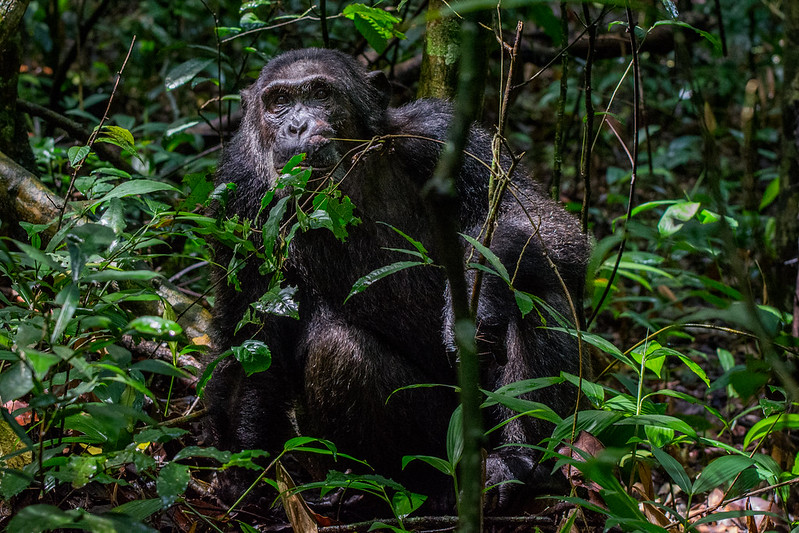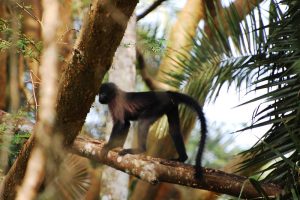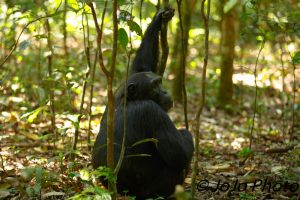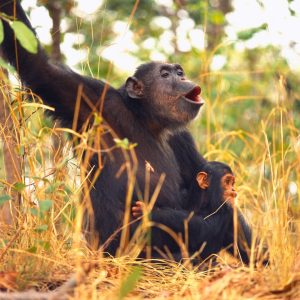Chimpanzee tracking in Kibale National Park
Chimpanzee tracking in Kibale National Park is one of Uganda’s most exhilarating wildlife experiences. Kibale National Park, often referred to as the “Primate Capital of the World,” is home to a variety of primates, but its main attraction is the large population of chimpanzees. Here’s a guide to what you can expect from chimpanzee tracking in this remarkable park:
Overview of Kibale National Park
- Location: Western Uganda, near the town of Fort Portal.
- Size: Approximately 795 square kilometers.
- Habitat: Primarily tropical rainforest, with patches of grassland and swamp.
- Biodiversity: Besides chimpanzees, Kibale is home to 12 other primate species, including red colobus monkeys, L’Hoest’s monkeys, and grey-cheeked mangabeys, as well as a rich variety of birds, butterflies, and other wildlife.
Chimpanzee Tracking Experience
- The Chimpanzees of Kibale
- Population: Kibale National Park hosts about 1,500 chimpanzees, making it one of the best places in Africa to observe them in their natural habitat.
- Behavior: Chimps in Kibale are habituated, meaning they are accustomed to human presence, allowing for closer and more frequent interactions.
- Tracking Excursion
- Starting Point: The activity typically begins at Kanyanchu Visitor Center, where you’ll be briefed by experienced Uganda Wildlife Authority (UWA) guides.
- Time: Morning (8 AM) and afternoon (2 PM) tracking sessions are available, each lasting 2-4 hours. Morning sessions are particularly popular, as chimps are most active during this time.
- Group Size: Limited to small groups of about 6-8 people to minimize disturbance to the chimpanzees.
- The Trek
- Difficulty: The trek varies in difficulty, depending on the location of the chimps. It may involve hiking through dense forest, uneven terrain, and sometimes muddy conditions.
- Duration: The actual time spent tracking can vary from 1 to 3 hours, depending on where the chimpanzees are located. Once you find them, you’ll spend about an hour observing their behavior.
- Wildlife Encounters: Along the way, you might also spot other primates, birds, and various flora, making the journey itself a rich experience.
- Observing the Chimpanzees
- Behavior: Watch as the chimpanzees feed, groom, play, and interact with one another. The guides will help identify different individuals and explain their behaviors.
- Photography: Capture moments of the chimps in their natural environment, but remember to maintain a respectful distance.
Chimpanzee Habituation Experience
- Description: For those seeking a more in-depth experience, Kibale offers the Chimpanzee Habituation Experience (CHEX). This full-day activity allows you to spend more time with the chimpanzees as they go about their daily routines.
- Benefits: You’ll have the chance to follow a chimpanzee group throughout the day, observing them from the moment they leave their nests in the morning until they settle down in the evening.
Best Time to Visit
- Dry Season: June to September and December to February are the best times for chimpanzee tracking, as trails are drier and easier to navigate.
- Wet Season: March to May and October to November can be challenging due to muddy conditions, but the park is lush, and the chances of seeing chimpanzees are still high.
What to Bring
- Clothing: Wear long sleeves, long pants, and sturdy hiking boots to protect against insects and forest vegetation. Neutral-colored clothing is recommended.
- Gear: Bring a rain jacket, hat, insect repellent, and a backpack with water and snacks. A camera with a good zoom lens is also essential for capturing the chimps.
- Permits: Chimpanzee tracking permits are required and should be booked in advance, especially during peak season. The permit cost is around $200 for the standard tracking experience.
Tips for a Successful Tracking Experience
- Be Prepared for the Hike: The trek can be physically demanding, so a reasonable level of fitness is necessary.
- Follow the Guide’s Instructions: Always listen to your guide, maintain a safe distance from the chimpanzees, and avoid sudden movements.
- Respect the Wildlife: Keep noise to a minimum, and do not eat or drink near the chimpanzees to avoid disturbing them.
Other Activities in Kibale National Park
- Primate Walks: Besides chimpanzee tracking, you can go on primate walks to see other species, such as the black-and-white colobus, vervet monkeys, and more.
- Bird Watching: Kibale is also a haven for birdwatchers, with over 370 species recorded in the park.
- Nature Walks: Explore the Bigodi Wetland Sanctuary, which offers guided walks through swampy forests rich in wildlife and birds.
Chimpanzee tracking in Kibale National Park is a once-in-a-lifetime experience that offers a deep connection with one of our closest living relatives. The combination of stunning natural beauty and the thrill of encountering wild chimpanzees makes this an unforgettable adventure.




